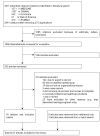Speaking up for patient safety by hospital-based health care professionals: a literature review
- PMID: 24507747
- PMCID: PMC4016383
- DOI: 10.1186/1472-6963-14-61
Speaking up for patient safety by hospital-based health care professionals: a literature review
Abstract
Background: Speaking up is important for patient safety, but often, health care professionals hesitate to voice concerns. Understanding the influencing factors can help to improve speaking-up behaviour and team communication. This review focused on health care professionals' speaking-up behaviour for patient safety and aimed at (1) assessing the effectiveness of speaking up, (2) evaluating the effectiveness of speaking-up training, (3) identifying the factors influencing speaking-up behaviour, and (4) developing a model for speaking-up behaviour.
Methods: Five databases (PubMed, MEDLINE, CINAHL, Web of Science, and the Cochrane Library) were searched for English articles describing health care professionals' speaking-up behaviour as well as those evaluating the relationship between speaking up and patient safety. Influencing factors were identified and then integrated into a model of voicing behaviour.
Results: In total, 26 studies were identified in 27 articles. Some indicated that hesitancy to speak up can be an important contributing factor in communication errors and that training can improve speaking-up behaviour. Many influencing factors were found: (1) the motivation to speak up, such as the perceived risk for patients, and the ambiguity or clarity of the clinical situation; (2) contextual factors, such as hospital administrative support, interdisciplinary policy-making, team work and relationship between other team members, and attitude of leaders/superiors; (3) individual factors, such as job satisfaction, responsibility toward patients, responsibility as professionals, confidence based on experience, communication skills, and educational background; (4) the perceived efficacy of speaking up, such as lack of impact and personal control; (5) the perceived safety of speaking up, such as fear for the responses of others and conflict and concerns over appearing incompetent; and (6) tactics and targets, such as collecting facts, showing positive intent, and selecting the person who has spoken up.
Conclusions: Hesitancy to speak up can be an important contributing factor to communication errors. Our model helps us to understand how health care professionals think about voicing their concerns. Further research is required to investigate the relative importance of different factors.
Figures
Similar articles
-
Classification of influencing factors of speaking-up behaviour in hospitals: a systematic review.BMC Health Serv Res. 2024 Dec 28;24(1):1657. doi: 10.1186/s12913-024-12138-x. BMC Health Serv Res. 2024. PMID: 39732664 Free PMC article.
-
Silence that can be dangerous: a vignette study to assess healthcare professionals' likelihood of speaking up about safety concerns.PLoS One. 2014 Aug 12;9(8):e104720. doi: 10.1371/journal.pone.0104720. eCollection 2014. PLoS One. 2014. PMID: 25116338 Free PMC article.
-
Trade-offs between voice and silence: a qualitative exploration of oncology staff's decisions to speak up about safety concerns.BMC Health Serv Res. 2014 Jul 14;14:303. doi: 10.1186/1472-6963-14-303. BMC Health Serv Res. 2014. PMID: 25017121 Free PMC article.
-
Improving safety through speaking up: An ethical and financial imperative.J Healthc Risk Manag. 2019 Jul;39(1):19-27. doi: 10.1002/jhrm.21360. Epub 2019 Apr 12. J Healthc Risk Manag. 2019. PMID: 30977243
-
Factors Influencing Nurses' Willingness to Speak Up Regarding Patient Safety in East Asia: A Systematic Review.Risk Manag Healthc Policy. 2021 Mar 12;14:1053-1063. doi: 10.2147/RMHP.S297349. eCollection 2021. Risk Manag Healthc Policy. 2021. PMID: 33737846 Free PMC article. Review.
Cited by
-
The impact of patient safety culture and the leader coaching behaviour of nurses on the intention to report errors: a cross-sectional survey.BMC Nurs. 2020 Sep 21;19:89. doi: 10.1186/s12912-020-00472-4. eCollection 2020. BMC Nurs. 2020. PMID: 32973398 Free PMC article.
-
How do cultural elements shape speak-up behavior beyond the patient safety context? An interprofessional perspective in an obstetrics and gynecology department.Front Med (Lausanne). 2024 Sep 4;11:1345316. doi: 10.3389/fmed.2024.1345316. eCollection 2024. Front Med (Lausanne). 2024. PMID: 39296909 Free PMC article.
-
Team communication amongst clinical teachers in a formal meeting of post graduate medical training.Adv Health Sci Educ Theory Pract. 2016 Mar;21(1):207-19. doi: 10.1007/s10459-015-9627-8. Epub 2015 Jul 31. Adv Health Sci Educ Theory Pract. 2016. PMID: 26228705 Free PMC article.
-
There is an App for That: Mobile Technology Improves Complication Reporting and Resident Perception of Their Role in Patient Safety.JB JS Open Access. 2021 Jan 20;6(1):e20.00077. doi: 10.2106/JBJS.OA.20.00077. eCollection 2021 Jan-Mar. JB JS Open Access. 2021. PMID: 33748638 Free PMC article. Review.
-
Factors influencing newly graduated registered nurses' voice behaviour: An interview study.J Nurs Manag. 2022 Oct;30(7):3189-3199. doi: 10.1111/jonm.13742. Epub 2022 Aug 1. J Nurs Manag. 2022. PMID: 35862097 Free PMC article.
References
-
- WHO Patient Safety Curriculum Guide. WHO patient safety curriculum guide. http://www.who.int/patientsafety/education/curriculum/en/
-
- Edmondson A. Speaking up in the operating room: how team leaders promote learning in interdisciplinary action teams. J Manag Stud. 2003;14(6):1419–1452. doi: 10.1111/1467-6486.00386. - DOI
Publication types
MeSH terms
LinkOut - more resources
Full Text Sources
Other Literature Sources
Medical



